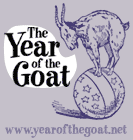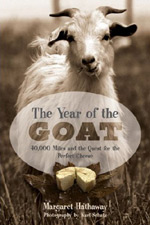A young woman ushered us through the dining room and into the wine room, which is connected to the cheese cave, where Max was setting up the evening's cheese cart. He greeted us, then continued to fuss over cheese placements, moving, sniffing, and prodding his cheeses into just the right positions. As we talked, I sat on a chair and Karl moved around taking photos of the cheeses in motion. Max answered our questions as he moved in and out of his temperature-regulated cheese cave, speaking for the most part in modulated tones (which were sometimes lost in the tunnel of cheese), but suddenly becoming impassioned about such issues as pasteurization and the global effects of European cheese subsidies.
One of our final questions was what Max would put on an all goat cheese plate, and in answer, he made up a sample plate for us. Surrounding a pile of fig and almond cake, prune and walnut cake, the Spanish quince paste called membrillo, and two Medjool dates were, in the order in which they were to be eaten, small slabs of: Chabichou du Poitou, Mont Saint Francis, Ibores, and Harbourne Blue. The cheeses were arranged in order of their delicacy, with the smooth, milder cheeses beginning the plate, and a final veined blue cheese rounding it out. We sat in the cafe of the restaurant, and Max also sent us glasses of wines to try with the cheeses, suggesting a Pouilly-Fumé with the first three, and a sweet Quart-de-Chaume with the last. My favorite of the cheeses was the first, the Chabichou, which was from the Loire Valley and reminded me of a creamy goat cheese my mom bought when I was little and we lived in France. Karl's favorite went back and forth between the Mont Saint Francis and the Ibores; though he normally doesn't like blue cheeses, he even liked the Harbourne Blue.
Once we'd had a bite of everything in the order Max had recommended, we experimented with pairing the cheeses with the different wines and accompaniments. What really astonished us was how the flavors of the cheeses totally changed depending upon the wine or the bit of dried fruit that followed. As Max recommends in his book, we tried to focus on each flavor and at once describe and dissect what we were tasting. The whole experience felt very civilized, and we left feeling truly grateful to Max for the afternoon. —MMH


